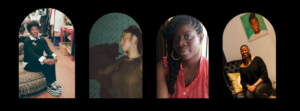Join us for a conversation with several Black women creative entrepreneurs traversing fashion, vintage, and design here in Chicago.
SSCAC is proud to host a panel of Black women entrepreneurs whose business models have been crafted to be intentionally centered on fashion, style, vintage, design and jewelry – creating worlds and community within their respective businesses and practices! Featured panelists will include stylist and fashion archivist Mallory Talty, Jeneba Koroma of Limba Gal, Shari Currie of Recycled Modern, and Gilda Norris of Gilda’s Designer Boutique!





